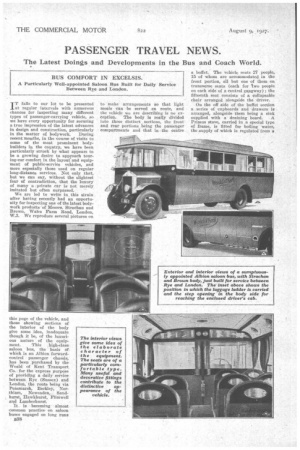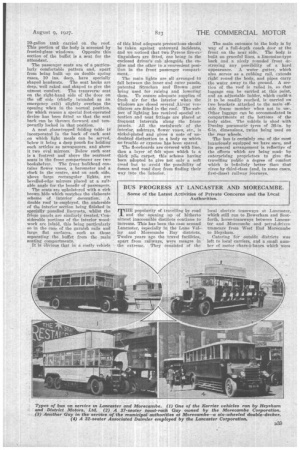PASSENGER TRAVEL NEWS.
Page 56

Page 57

If you've noticed an error in this article please click here to report it so we can fix it.
The Latest Doings and Developments in the Bus and Coach World.
BUS COMFORT IN EXCELSIS.
A Particularly Well-appointed Saloon Bus Built for Daily Service Between Rye and London.
TTfalls to our lot to be presented at regular intervals with numerous chances for inspecting many different types of passenger-carrying vehicle, so we have every opportunity for securing a true impression of the latest advances in design and construction, particularly in the matter of bodywork. During recent months, in the course of visits to some of the most prominent bodybuilders in the country, we have been particularly struck by what appears to be a growing desire to approach touring-car comfort in the layout and equipment of public-service vehicles, and more especially those used on regular long-distance services. Not only that, but we can say, without the slightest fear of contradiction, that the luxury of many a private car is not merely imitated but often surpassed.
We are led to write in this strain after hating recently had an opportunity for inspecting one of the latest bodywork products of Messrs. Straehan and Brown, Wales Farm Road, London, W.3. We reproduce several pictures on this page of the vehicle, and those showing sections of the interior of the body give some idea, inadequate though it be, of the luxurious nature of the equipment. This high-class saloon bus, the basis of which is an Albion forwardcontrol passenger chassis, has been purchased by the Weald of Kent Transport eo. for the express purpose of providing a daily service between Rye (Sussex) and Loudon, the route being via Peasmarsh, Beckley, Northiam, Newenden, . Sandhurst. Hawkhurst, Flimwell and Lamberhurst.
It, is becoming almostcommon practice on saloon buses engaged on long runs B38 to make arrangements so that light meals can be served en route, and the vehicle we are describing is no ex ception. The body is really divided into three distinct. sections, the front and rear portions being the passenger compartments and that in the centre a buffet. The A.iehiele seats 27 people, 15 of whom are accommodated in the front portion, all but one of them on transverse seats (each for two people on each side of a central gangway) ; the fifteenth seat consists of a collapsable chair arranged alongside the driven On the off side of the buffet section a series of cupboards and drawers is arranged, alongside them being a sink supplied with a draining board. A Primus stow, carried in a special type of frame, is fitted for boiling water, the supply of which is regulated from a 20-gallon tank carried on the roof. This portion of the body is screened by frosted-glass windows. Opposite this section of the buffet is a seat for the attendant.
The passenger seats are of a particularly comfortable pattern and apart from being built up on double spring cases, 10 ins, deep, have specially shaped headnests. The seat backs are deep, well raked and shaped to give the utmost comfort. The transverse seat on the right-hand side of the door on the off side (chiefly intended as an emergency exit) slightly overlaps the opening when in the normal position, for which reason a special foot-operated device has been fitted so that the seat back can be thrown forward, and temporarily locked in that position.
A neat glass-topped folding table is incorporated in the back of each seat on which light meals can be served, below it being a deep pouch for holding such articles as newspapers, and above it two oval mirrors. Below each seat is a footrest and above the rearmost seats in the front compartment are two bookshelves. The front bulkhead contains flower vases, a barometer and a clock in the centre, and on each side, 'above large rectangular lights, are bevelled-edge mirrors placed at a suitable angle for the benefit of passengers. • The seats are upholstered with a rich brown hide which matches the elaborate scheme of interior decoration. A double roof is employed, the underside of the interior section being finished in specially panelled lincrusta, whilst the frieze panels are similarly treated. Considerable portions of the interior woodwork are inlaid, this being particularly so in the case of the garnish rails and large flat surfaces, such as those separating the buffet from the main seating compartments.
It is avious that in a costly vehicle of this kind adequate precautions should be taken against untoward incidents and we noticed that two Pyrene fire-extinguishers are fitted, one being in the enclosed driver's cab alongside the engine and the other in a convenient positionin the front passenger compartment.
The main lights are all arranged to fall between the inner and outer panels, patented Strachan and Brown gear being used for raising and lowering them. To ensure adequate supplies of fresh air for the interior when the windows are closed several Airvac ventilators are fitted in the roof. The subject of lighting has received special attention and neat fittings are placed at frequent intervals along the frieze panels. All the metalwork of the interior, ashtrays, flower vases, etc„ is nickel-plated and gives a note of undoubted distinction to a body on which no trouble or expense has been spared.
The floorboards are covered with lino, then a layer of felt upon which is a thick pile carpet, this scheme baying been adopted to give not only a soft tread but to avoid the possibility of fumes and road dust from finding their way into the interior. The main entrance to the body is by way of a full-depth coach door at the front on the near side. The body is built on gracefal lines, a limousine-type back and a nicely rounded front de-; stroying any possibility of a hard appearance. A water gutter, which also serves as a rubbing rail. extends right round the body, and pipes carry the water away to the ground. A section of the roof is railed in, so that luggage can be carried at this point, and an adjustable ladder, which enabl-a it to be readily reached, is carried on two brackets attached to the main offside frame member when not in usr. Other luggage can be accommodated in compartments at the bottoms of the body sides. The vehicle is shod with Dunlop pneumatic tyres of 2(1-in. by 6-in, dimensions, twins ,being used on the. rear wheels.
The bus is certainly one of the most luxuriously equipped we have urn. and its general arrangement is reflectiye of the efforts which are being madei by enterprising proprietors to give the travelling public a degree of comfort which is infinitely better than that given by third-class (and, in some caws, first-class) railway journeys.




































































































